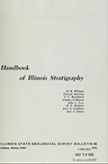Historical:Meppen Limestone
Lithostratigraphy: Mammoth Cave Limestone Megagroup >>Meppen Limestone
Chronostratigraphy: Paleozoic Erathem >>Mississippian Subsystem >>Valmeyeran Series
Allostratigraphy: Kaskaskia Sequence
Authors
Elwood Atherton, Charles Collinson, and Jerry A. Lineback
Name Origin
The Meppen Limestone (Collinson, 1969, p. 12) is named for the village of Meppen, Calhoun County.
Type Section
The type section of the Meppen Limestone is in a quarry 0.6 mile north of Meppen (SW NE 23, 12S-2W), where the formation is 7 feet thick.
Other Names
The Meppen Limestone was called Sedalia in Illinois for many years (Rubey, 1952; Collinson et al., 1954) because of its lithologic similarity to the upper dolomitic portion of the Chouteau Limestone in Missouri, which had been named Sedalia by Moore (1928). However, the conodont faunas have shown that the Missouri Sedalia is Kinderhookian, whereas the Illinois "Sedalia" is Valmeyeran.
Correlation
Lithologically and faunally, the Meppen correlates better with the Pierson Limestone of central Missouri than with the Sedalia.
Extent and Thickness
The formation occurs along the western edge of Illinois in an area extending from Calhoun County to Monroe County. It is well exposed in Calhoun and Jersey Counties and has a maximum thickness of 22 feet at Chautauqua, Jersey County (SE SE NE 13, 6N-12W).
Stratigraphic Position
The Meppen rests unconformably on the Chouteau Limestone, and at Chautauqua the relation is clearly angular. The Meppen is overlain conformably by the Fern Glen Formation, but north of the Lincoln Anticline the Fern Glen grades into the Burlington, and the Burlington overlaps the Meppen.
Description
At the type section, the Meppen Limestone consists of buff, massive dolomite containing numerous small calcite geodes, and stands out as a distinct buff band in the quarry face. The Meppen is a tan or buff, very fine-grained, slightly crinoidal, dolomitic limestone or calcareous dolomite that commonly contains many calcite geodes 0.5-2 inches in diameter.
Fossils
The Meppen contains lower Valmeyeran conodonts, such as Pseudopolygnathus multistriatus, Polygnathus communis carinus, and Bactrognathus hamatus, but no diagnostic Kinderhookian species. The conodont Gnathodus semiglaber--Pseudopolygnathus multistriatus Zone occurs in the Meppen Formation (Collinson et al., 1962).
References
COLLINSON, CHARLES, 1969, Devonian-Mississippian biostratigraphy of northeastern Missouri and western Illinois: North American Paleontological Convention Field Trip 3, 23 p.
COLLINSON, CHARLES, A. J. SCOTT, and C. B. REXROAD, 1962, Six charts showing biostratigraphic zones and correlations based on conodonts from the Devonian and Mississippian rocks of the Upper Mississippi Valley: Illinois State Geological Survey Circular 328, 32 p.
COLLINSON, CHARLES, D. H. SWANN, and H. B. WILLMAN, 1954, Guide to the structure and Paleozoic stratigraphy along the Lincoln Fold in western Illinois: Illinois State Geological Survey Guidebook Series 3, 75 p.
MOORE, R. C., 1928, Early Mississippian formations in Missouri: Missouri Bureau of Geology and Mines, v. 21, 283P.
RUBEY, W. W., 1952, Geology and mineral resources of the Hardin and Brussels Quadrangles: USGS Professional Paper 218, 179 p.
ISGS Codes
| Stratigraphic Code | Geo Unit Designation |
|---|---|
